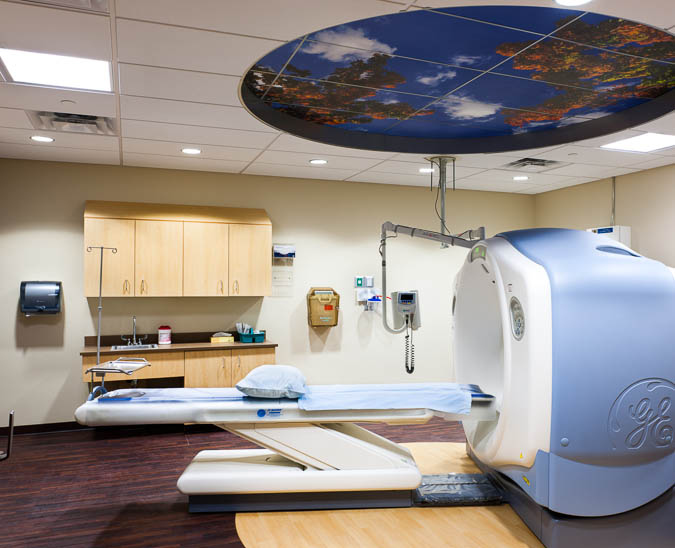
Picture of a CT Scan room with equipment that is used for assisting patients during the process. CT imaging combines special x-ray equipment with sophisticated computers to produce multiple images or pictures of the inside of the body. These cross-sectional images of the area being studied can then be examined on a computer monitor locally or remotely
CT Scan
What is CT Scanning of the Body?
CT scanning-sometimes called a CAT scan-is a noninvasive medical test that helps physicians diagnose and treat medical conditions.
CT imaging combines special x-ray equipment with sophisticated computers to produce multiple images or pictures of the inside of the body. These cross-sectional images of the area being studied can then be examined on a computer monitor locally or remotely.
CT scans of internal organs, bone, soft tissue, and blood vessels provide greater clarity and reveal more details than regular x-ray exams.
Using specialized equipment and expertise to create and interpret CT scans of the body, radiologists can more easily diagnose problems such as cancers, cardiovascular disease, infectious disease, trauma, and musculoskeletal disorders.
64 - Slice CT Scanner
Cabinet Peaks Medical Center has a 64-slice GE Revolution-evo CT Scanner with ASiR technology which enhances patient safety through reduction of radiation exposure. Additionally, the 64-slice CT increases patient comfort, provides fast, high resolution images of greater clarity for physicians, and expands diagnostic capabilities at CPMC.
What are some common uses of the procedure?

The CT is one of the best and fastest tools for studying the chest, abdomen, and pelvis because it provides detailed, cross-sectional views of all types of tissue.

The CT is often the preferred method for diagnosing many different cancers, including lung, liver, and pancreatic cancer, since the image allows a physician to confirm the presence of a tumor and measure its size, precise location, and the extent of the tumor's involvement with other nearby tissue.

The CT plays a significant role in the detection, diagnosis, and treatment of vascular diseases that can lead to stroke, kidney failure, or even death.

The CT is commonly used to assess for pulmonary embolism (a blood clot in the lung vessels) as well as for abdominal aortic aneurysms (AAA).

The CT is invaluable in diagnosing and treating spinal problems and injuries to the hands, feet, and other skeletal structures because it can clearly show very small bones, as well as surrounding tissues such as muscle and blood vessels.
Physicians often use the CT examination to...

quickly identify injuries to the lungs, heart and vessels, liver, spleen, kidneys, or other internal organs in cases of trauma.

plan for and assess the results of surgery.

measure bone mineral density for the detection of osteoporosis.
How should I prepare?
You should wear comfortable, loose-fitting clothing to your exam. You may be given a gown to wear during the procedure.
Metal objects including jewelry, eyeglasses, dentures, and hairpins may affect the CT images and should be left at home or removed prior to your exam. You may also be asked to remove hearing aids and removable dental work.
You may be asked not to eat or drink anything for several hours before your exam, especially if a contrast material will be used during the process. You should inform your physician of any medications you are taking and if you have any allergies. If you have a known allergy to contrast material, or "dye", your doctor may prescribe medications to reduce the risk of an allergic reaction.
Also inform your doctor of any recent illnesses or other medical conditions, and if you have a history of heart disease, asthma, diabetes, kidney disease, or thyroid problems. Any of these conditions may increase the risk of an unusual adverse effect.
Women should always inform their physician and the CT technologist if there is any possibility that they are pregnant.
Cabinet Peaks Medical Center
Imaging Services
209 Health Park Drive
Libby, MT 59923
(406)283-7080
More Information:
